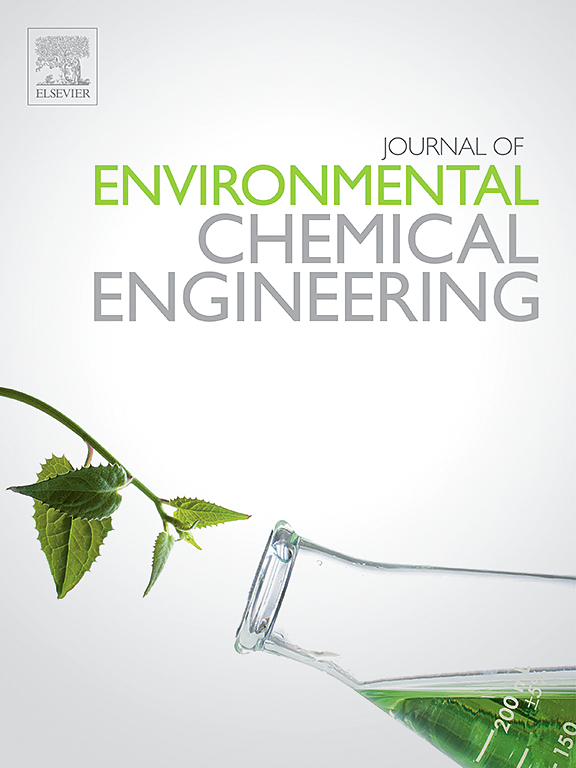Enhanced hydrolytic acidification with Zero-Valent Iron for efficient treatment of comprehensive wastewater from industrial parks: Mechanistic insights and toxicity reduction
IF 7.4
2区 工程技术
Q1 ENGINEERING, CHEMICAL
引用次数: 0
Abstract
In this study, a laboratory-scale zero-valent iron (ZVI)-enhanced hydrolytic acidification system was established to treat the comprehensive wastewater from Nanjing Jiangbei New Material Science Technology Park. Results indicated that the ZVI-enhanced hydrolytic acidification system achieved a maximum COD removal efficiency of 95.0 %, surpassing the performance of the system without ZVI by 12.2 %. Microbial community analysis revealed the enrichment of electrogenic bacterium Bacteroidetes_vadinHA17 and typical hydrogenotrophic methanogen Methanobacterium due to ZVI addition. High-throughput sequencing combined with PICRUSt2 analysis demonstrated acetate production was promoted, and butyrate and propionate production was inhibited. Additionally, Oxygen Uptake Rate-based toxicity assays revealed the hydrolytic acidification system transitioned the wastewater of three enterprises from low toxicity to non-toxic status and two from high to low toxicity. While the ZVI-enhanced hydrolytic acidification system successfully reduced the toxicity of all highly and low toxic wastewaters to non-toxic levels.
利用零价铁强化水解酸化,高效处理工业园区的综合废水:机理认识与毒性降低
本研究建立了实验室规模的零价铁(ZVI)强化水解酸化系统,用于处理南京江北新材料科技园的综合废水。结果表明,零价铁强化水解酸化系统对 COD 的最大去除率为 95.0%,比不使用零价铁的系统高出 12.2%。微生物群落分析表明,ZVI 的添加富集了电生细菌 Bacteroidetes_vadinHA17 和典型的氢营养甲烷菌 Methanobacterium。高通量测序结合 PICRUSt2 分析表明,醋酸盐的生产得到了促进,而丁酸盐和丙酸盐的生产受到了抑制。此外,基于氧吸收率的毒性试验表明,水解酸化系统使三家企业的废水从低毒性状态转变为无毒性状态,两家企业的废水从高毒性状态转变为低毒性状态。而 ZVI 增强型水解酸化系统则成功地将所有剧毒和低毒废水的毒性降至无毒水平。
本文章由计算机程序翻译,如有差异,请以英文原文为准。
求助全文
约1分钟内获得全文
求助全文
来源期刊

Journal of Environmental Chemical Engineering
Environmental Science-Pollution
CiteScore
11.40
自引率
6.50%
发文量
2017
审稿时长
27 days
期刊介绍:
The Journal of Environmental Chemical Engineering (JECE) serves as a platform for the dissemination of original and innovative research focusing on the advancement of environmentally-friendly, sustainable technologies. JECE emphasizes the transition towards a carbon-neutral circular economy and a self-sufficient bio-based economy. Topics covered include soil, water, wastewater, and air decontamination; pollution monitoring, prevention, and control; advanced analytics, sensors, impact and risk assessment methodologies in environmental chemical engineering; resource recovery (water, nutrients, materials, energy); industrial ecology; valorization of waste streams; waste management (including e-waste); climate-water-energy-food nexus; novel materials for environmental, chemical, and energy applications; sustainability and environmental safety; water digitalization, water data science, and machine learning; process integration and intensification; recent developments in green chemistry for synthesis, catalysis, and energy; and original research on contaminants of emerging concern, persistent chemicals, and priority substances, including microplastics, nanoplastics, nanomaterials, micropollutants, antimicrobial resistance genes, and emerging pathogens (viruses, bacteria, parasites) of environmental significance.
 求助内容:
求助内容: 应助结果提醒方式:
应助结果提醒方式:


